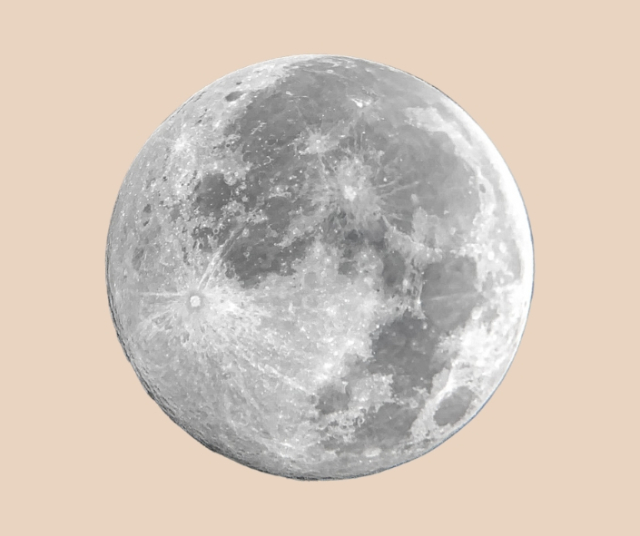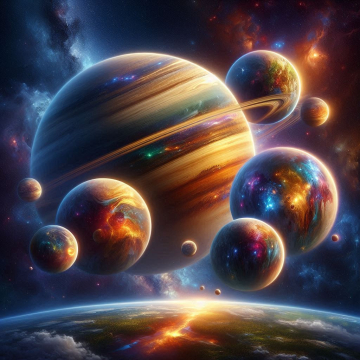The Moon , our natural satellite, has been an object of fascination and mystery since time immemorial. Throughout human history, it has been a source of inspiration for countless myths and legends that have enriched the culture of different civilizations. From ancient times to the modern era, the Moon has played a fundamental role in mythology and the human imagination.
The Moon in Greek Mythology
Let's begin our journey in ancient Greece, where the Moon was personified by the goddess Selene. Selene was considered the personification of the Moon in its most divine form, and was depicted as a beautiful woman riding across the sky in her silver chariot. Selene was said to have fallen in love with Endymion, a mortal shepherd, and visited him every night while he slept. This love story between a goddess and a mortal became one of the most romantic myths in Greek mythology.
Another important character in Greek mythology related to the Moon is Artemis, the twin sister of Apollo. Artemis was the goddess of the hunt and protector of nature, and was closely associated with the Moon. It was said to hunt at night, guided by the light of the Moon, and protect creatures from darkness. His bow and arrows, symbols of hunting, were also associated with the Moon.
The Moon in Egyptian Mythology
In ancient Egypt, the Moon was represented by the god Thoth. Thoth was the god of wisdom, writing and the moon, and was associated with the measurement of time. The Egyptians believed that the Moon ruled the night and that its phases were related to the cycle of life and death. Thoth played a key role in Egyptian mythology, as he was credited with writing the Pyramid Texts, which were essential funerary rituals for the pharaohs on their journey to the afterlife.
The Moon in Chinese Mythology
The Moon also plays a prominent role in Chinese mythology. In Chinese culture, the Moon is linked to the Mid-Autumn festival, a celebration that takes place on the fifteenth day of the eighth lunar month. During this festival, families gather to watch the full moon and enjoy traditional foods, such as the famous mooncakes. The best-known story of the Mid-Autumn Festival is the legend of Chang'e, the goddess of the Moon.
According to legend, Chang'e was the wife of Hou Yi, a brave archer who saved the Earth from ten scorching suns. As a reward, Hou Yi received an elixir of immortality, but instead of taking it, he entrusted it to his wife. However, Chang'e was tempted by immortality and decided to drink the elixir. Instead of granting her immortality, the elixir caused her to fly to the Moon, where she became trapped. Since then, Chang'e lives on the Moon, accompanied by a lunar rabbit. This legend is one of the most iconic stories in Chinese mythology and is celebrated every year during the Mid-Autumn Festival.
The Moon in Mayan Mythology
The Moon also played an important role in Mayan mythology. The Mayans had a close relationship with astronomy and observed the phases of the Moon in great detail. According to Mayan mythology, the Moon was related to the god Kukulkan, a feathered serpent who was one of the most important deities in the Mayan religion.
Kukulkan was linked to the creation of the world and was attributed the ability to move the Moon and the stars. The Mayans believed that Kukulkan descended to Earth during lunar and solar eclipses to communicate with humans. The Mayans developed precise lunar calendars that allowed them to predict eclipses and other astronomical events with great accuracy.
The Moon in Norse Mythology
In Norse mythology, the Moon was related to the god Máni. Máni was the guardian of the Moon and was responsible for guiding it through the night sky. According to Norse mythology, Máni and her sister Sól, the goddess of the Sun, were chased by wolves that represented the passage of time. It was believed that eventually the wolves would overtake Máni and Sól, leading to the end of the world in the event known as Ragnarök.
Máni was also linked to madness and dementia, as mental disorders were believed to be related to the influence of the Moon. The Norse believed that people could go crazy if they looked at the full Moon for too long.
The Moon in Hindu Mythology
In Hindu mythology, the Moon was personified as the god Chandra. Chandra was the god of the Moon and was represented as a young man with an antelope horn on his head. He was credited with the ability to influence people's emotions and moods.
Chandra was also involved in a love affair with the twenty-seven star wives known as the "Nakshatras". These star wives were daughters of Daksha, a Hindu god. Chandra was said to favor one of the wives, Rohini, over the others, causing jealousy and rivalries between them. This story became a recurring theme in Hindu literature and art.
The Moon in African Mythology
In African mythology, the Moon also plays an important role. In different African cultures, the Moon is associated with various gods and goddesses. For example, in West African Yoruba mythology, the Moon is related to the goddess Yemayá, the mother of all deities. Yemayá is associated with water and fertility, and its influence extends to the Moon and its cycles.
In the mythology of the Zulus of South Africa, the Moon is personified as the goddess Mawu-Lisa. Mawu is the goddess of the Moon, while Lisa is the god of the Sun. Mawu-Lisa is believed to be responsible for maintaining the balance between light and darkness in the world. This duality between the Sun and the Moon is a recurring theme in many African mythologies.
The Moon in Amerindian Mythology
The indigenous cultures of America also have their own mythologies related to the Moon. In Native American Hopi mythology, the Moon is related to the goddess Tsuku, who is considered the mother of all living things. Tsuku is believed to influence fertility and the life cycle.
In the Lakota mythology of the Native Americans of the Great Plains, the Moon is personified as Hanwi, the sister of Wi, the Sun. Hanwi is believed to guide the spirits of the dead to the afterlife and that its light provides guidance to the dead. night hunters
The Influence of the Moon on Popular Culture
The Moon and its myths have also left their mark on popular culture and modern literature. One of the best-known examples is the short story " A Trip to the Moon " by Jules Verne, published in 1865. In this work, a group of scientists travel to the Moon aboard a space projectile, anticipating space exploration in real life. which would happen more than a century later.
The Moon has also been a source of inspiration in music. The song " Bad Moon Rising " by Creedence Clearwater Revival, for example, references an ominous Moon that foreshadows unfortunate events. Similarly, The Police's "Walking on the Moon" is an homage to the feeling of lightness and freedom that comes from walking on the Moon.
In cinema, the Moon has been the setting for numerous films, from Georges Méliès ' iconic " A Trip to the Moon " in 1902 to the 2009 science fiction film "Moon," which explores issues of identity and loneliness on the Moon. .
Each culture has found its own way of interpreting and relating to the Moon, which has given rise to a rich diversity of stories and traditions. The Moon has influenced religion, astronomy, poetry, music and literature throughout history, and its influence continues to be palpable in contemporary culture.






